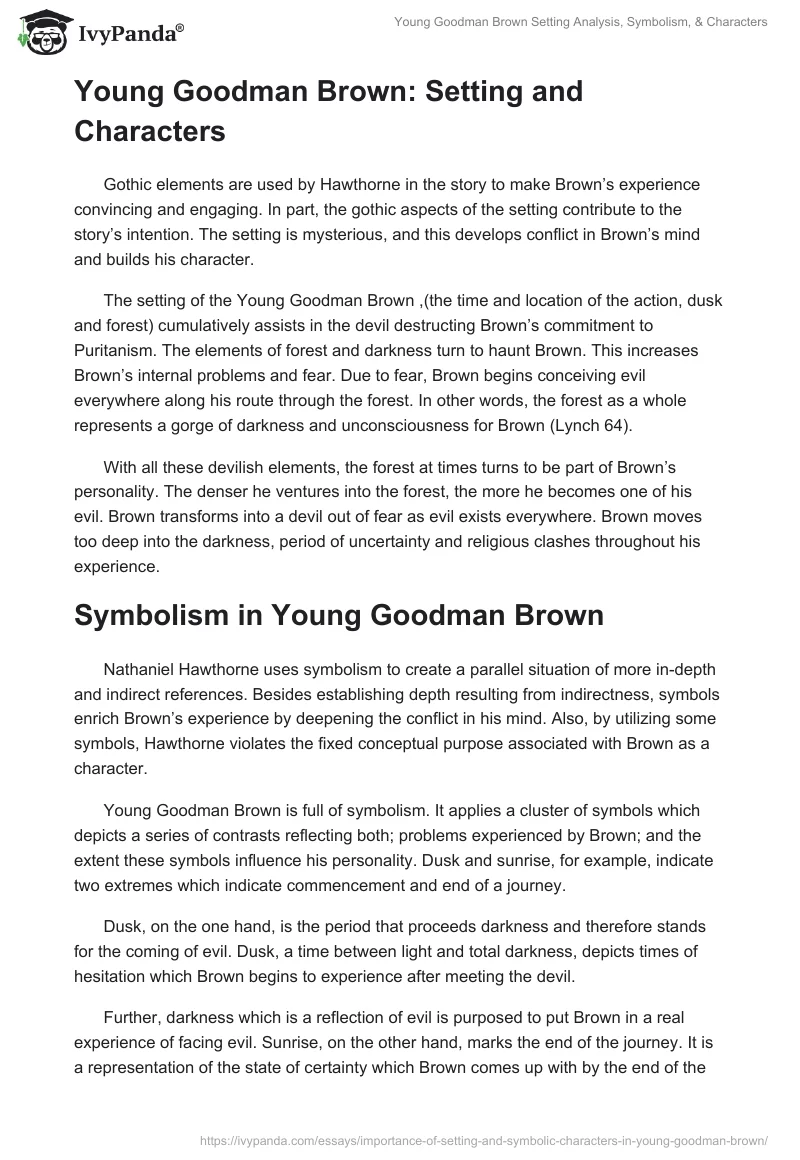Need to analyze Young Goodman Brown setting? This essay on Nathaniel Hawthorne’s short story explores the symbols, themes, characters, & setting of Young Goodman Brown.
Introduction
The setting in The Young Goodman Brown influences the development of plot and character. The setting of a play is a crucial element in terms of establishing direction, feel and structure that a specific story carries. Usually, a reflection of numerous essential aspects of work; culture, time, location and tone is determined through the setting of the story. That is how an ambience and emotional connotation within readers are created.
The characters in Young Goodman Brown are direct and sure by-products of communities and environments in which they live. The story portrays a paradigm of a setting’s significance. It exemplifies the importance of setting as it reflects and applies to the core meaning of the piece. The story’s background provides a historical look into the characters and their lifestyles.
For example, one quickly discovers that Brown lives in a puritan society in the 17th century (Crowley 65). Thus, several inferences of the character of Brown can be made. This essay is an analysis of the story’s setting, symbolism and characters.I’ve selected the character of Brown, who contends with aspects of the past. It illustrates how Hawthorne’s setting and symbolism of the Young Goodman Brown contribute to the meaning of the entire piece.
Young Goodman Brown: Setting and Characters
Gothic elements are used by Hawthorne in the story to make Brown’s experience convincing and engaging. In part, the gothic aspects of the setting contribute to the story’s intention. The setting is mysterious, and this develops conflict in Brown’s mind and builds his character.
The setting of the Young Goodman Brown ,(the time and location of the action, dusk and forest) cumulatively assists in the devil destructing Brown’s commitment to Puritanism. The elements of forest and darkness turn to haunt Brown. This increases Brown’s internal problems and fear. Due to fear, Brown begins conceiving evil everywhere along his route through the forest. In other words, the forest as a whole represents a gorge of darkness and unconsciousness for Brown (Lynch 64).
With all these devilish elements, the forest at times turns to be part of Brown’s personality. The denser he ventures into the forest, the more he becomes one of his evil. Brown transforms into a devil out of fear as evil exists everywhere. Brown moves too deep into the darkness, period of uncertainty and religious clashes throughout his experience.
Symbolism in Young Goodman Brown
Nathaniel Hawthorne uses symbolism to create a parallel situation of more in-depth and indirect references. Besides establishing depth resulting from indirectness, symbols enrich Brown’s experience by deepening the conflict in his mind. Also, by utilizing some symbols, Hawthorne violates the fixed conceptual purpose associated with Brown as a character.
Young Goodman Brown is full of symbolism. It applies a cluster of symbols which depicts a series of contrasts reflecting both; problems experienced by Brown; and the extent these symbols influence his personality. Dusk and sunrise, for example, indicate two extremes which indicate commencement and end of a journey.
Dusk, on the one hand, is the period that proceeds darkness and therefore stands for the coming of evil. Dusk, a time between light and total darkness, depicts times of hesitation which Brown begins to experience after meeting the devil.
Further, darkness which is a reflection of evil is purposed to put Brown in a real experience of facing evil. Sunrise, on the other hand, marks the end of the journey. It is a representation of the state of certainty which Brown comes up with by the end of the story. This moment forms clarity in Brown’s belie and attitude towards the village people. This contrast of light and darkness is another good example of symbolism in the Young Goodman Brown.
Conclusion
In summary, the Young Goodman Brown is a Puritanism satire. From the author’s point of view, it is a belief system that pursues an ideology that deepens conflicts and divisions. It discards all efforts at establishing any common position among the numerous Christian sects on the one hand, and other beliefs on the other.
The aspect of Puritanism, through distrust and doubt, encourages the possibility of splitting societies over religious issues at the expense of unity and togetherness. It tries to expel those who are not Puritans and those who do not conform and looks upon them as sinners. This past attends negatively on Brown’s personality as he obeys out of fear.
The story offers historical insight into the character of Brown and his lifestyle. For instance, we quickly understand that Brown lives in a Puritan society right from the onset. We can see Puritanism in some aspects as unrelenting and biased. Puritanism is a Christian sect that looks upon its members as the only devout and looks upon members of other sects as non-conformists.
The Puritans believe that they are the only ones who should be admitted in the membership of the church. The congregations of such individuals portray the true church. The sect does not tolerate others and relates itself to the devil against general humanity (Lynch 65).
This sort of extremism of Puritan principles indicates the spread of puritan ideology and its reception among people. Thus, the bias nature of Puritanism leads to hatred, distrust and segmentation among human beings. According to Lynch (2009; P. 69), puritans established themselves a distrustful society for a vibrant congregation which would later harm them.
The main character of Young Goodman Brown is a reflection of the puritan ideology. In him, Hawthorne’s Puritanism is satirized as the dominant faith in his hometown. He looks at Puritanism in a manner to suggest his disillusionment and dissatisfaction with it as a system of belief. In the descriptions of Goodman Brown, Hawthorne seems to discover back his personal experiences with puritans (Lynch 70).
Works Cited
Crowley, Joseph. Nathaniel Hawthorne. New York: Taylor & Francis, 1971.
Lynch, John. Nathaniel Hawthorne. Massachusetts: Salem Press, 2009.


